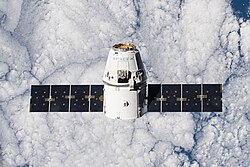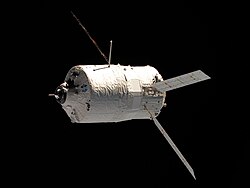ATV-005 Georges Lemaître
| ATV-005 Georges Lemaître | |||
 | |||
| Uppkallad efter | Georges Lemaître | ||
|---|---|---|---|
| Modell | Automated Transfer Vehicle | ||
| Färdens tid | 200 dagar, 17 timmar | ||
| Massa | 20 293 kg | ||
| NSSDC-ID | 2014-044A[1] | ||
| Uppskjutning | |||
| Startplats | ELA 3 Centre Spatial Guyanais | ||
| Raket | Ariane 5 ES ATV | ||
| Uppskjutning | 29 juli 2014, 23:47:38 UTC | ||
| Återinträde | |||
| Återinträde | 15 februari 2015 | ||
| Omloppsbana | |||
| Apogeum | 422 km | ||
| Perigeum | 412 km | ||
| Banlutning | 51,6° | ||
| Varv | 3 120 st[2] | ||
| Dockning | |||
| Rymdstation | ISS | ||
| Dockning | 12 augusti 2014, 13:30 UTC | ||
| Dockningsport | Zvezda Akter | ||
| Ur dockning | 14 februari 2015, 13:42 UTC | ||
| Tid dockad | 186 dagar, 12 minuter | ||
| Kronologi | |||
| |||
ATV-005 Georges Lemaître var ESA:s femte och sista Automated transfer vehicle för att leverera förnödenheter, syre, vatten och bränsle till rymdstationen ISS. Uppskjutningen skede den 29 juli 2014, med en Ariane 5 ES ATV raket. Farkosten namngavs efter den belgiske katolska prästen och astronomen, Georges Lemaître. Dockningen med rymdstationen skede den 12 augusti 2014. Efter att ha fyllts med sopor lämnade farkosten rymdstationen den 14 februari 2015. Dagen efter, 15 februari, brann den som planerat upp i jordens atmosfär.
Källor
Fotnoter
- ^ ”NASA Space Science Data Coordinated Archive” (på engelska). https://nssdc.gsfc.nasa.gov/nmc/spacecraft/display.action?id=2014-044A. Läst 26 februari 2020.
- ^ Manned Astronautics - Figures & Facts Arkiverad 3 oktober 2015 hämtat från the Wayback Machine., läst 28 juli 2016.
| |||||||||||||
| ||||||||||||||||||||||||||||||||
Media som används på denna webbplats
This image, photographed by one of the Expedition 42 crew members aboard the International Space Station, shows the SpaceX Dragon cargo craft approaching on Jan. 12 2015 for its grapple and berthing and the start of a month attached to the complex. Dragon carried more than 2 ½ tons of supplies and experiments to the station.
ISS021-E-017623 (30 Oct. 2009) --- Backdropped by a cloud-covered part of Earth, the unpiloted Japanese H-II Transfer Vehicle (HTV), filled with trash and unneeded items, departs from the International Space Station. European Space Agency astronaut Frank De Winne, Expedition 21 commander; NASA astronaut Nicole Stott and Canadian Space Agency astronaut Robert Thirsk, both flight engineers, used the station's Canadarm2 robotic arm to grab the HTV cargo craft and unberth it from the Harmony node's nadir port. The HTV was successfully unberthed at 10:18 a.m. (CDT) on Oct. 30, 2009, and released from the station's Canadarm2 at 12:32 p.m.
A Progress supply ship linked up to the orbiting International Space Station (ISS) at 3:48 GMT, November 18, bringing Expedition 1 commander William M. Shepherd, pilot Yuri P.
Gidzenko and flight engineer Sergei K. Krikalev two tons of food, clothing, hardware and holiday gifts from their families. The photograph was taken with a 35mm camera and the film was later handed over to the STS-97 crew members
for return to Earth and subsequent processing.Drawing of ESA's Automated Transfer Vehicle
Surrounded by the blackness of space, the European Space Agency's Automated Transfer Vehicle-4 (ATV-4) "Albert Einstein" approaches the International Space Station. The spacecraft went on to successfully dock to the orbital outpost at 2:07 GMT, June 15, 2013, following a ten-day period of free-flight.
Backdropped by a cloud-covered part of Earth, the Orbital Sciences' Cygnus cargo craft approaches the International Space Station, photographed by an Expedition 40 crew member. The two spacecraft converged at 6:36 a.m. (EDT) on July 16, 2014.
ISS026-E-037172 (24 Feb. 2011) --- Surrounded by the blackness of space, the European Space Agency's "Johannes Kepler" Automated Transfer Vehicle-2 (ATV-2) approaches the International Space Station. Docking of the two spacecraft occurred at 10:59 a.m. (EST) on Feb. 24, 2011.









